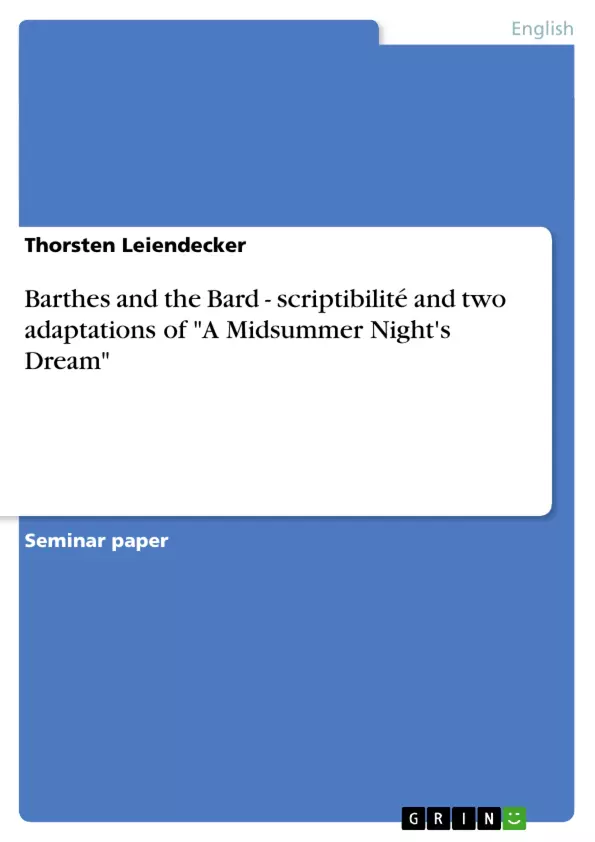In this paper I discuss two film adaptations of Shakespeare's A Midsummer Night's Dream: Adrian Noble's TV production from 1996 and Michael Hoffman's Hollywood film from 1998. The two versions offer different contemporary readings of a text, so that it is not only Shakespeare we evaluate but also ourselves and what our occupation with his texts signifies.
The methodological key concepts employed are Roland Barthes's critical terms from S/Z, the writerly and the readerly (scriptibilité and lisibilité), as well his own cinematic terminology of 'the third meaning'. Used in the anaysis, these concepts support the critical differentiation of the Hollywood blockbuster and the art house production, their specific filmic properties and their social functions.
Inhaltsverzeichnis (Table of Contents)
- Introduction
- (Re)Writing a Film with Roland Barthes
- Scriptibilité/Lisibilité
- Application on Film: The Third Meaning
- Summary
- Hoffman and/or Noble
- Additions of Character(istic)s
- The Mise-en-scène
- The Cupid-Scene
- Sex and Eroticism
- Stage vs. Screen
- Conclusion: It's still a Shakespeare Movie
Zielsetzung und Themenschwerpunkte (Objectives and Key Themes)
This paper analyzes two film adaptations of A Midsummer Night's Dream, one by Adrian Noble and one by Michael Hoffman, to investigate how they utilize the concept of "scriptibilité" – the degree to which a text can be rewritten – as developed by Roland Barthes. The analysis aims to determine the films' communicative strategies and their processes of signification, specifically examining how they present character, mise-en-scène, acting, sexuality, and the relationship between stage and screen.
- The concept of "scriptibilité" as defined by Roland Barthes and its application to film adaptations.
- An examination of how the two A Midsummer Night's Dream film adaptations utilize "scriptibilité" in their communication of meaning.
- The role of character, mise-en-scène, acting, sexuality, and the relationship between stage and screen in conveying meaning in the films.
- The relationship between the text and the time it is reproduced in relation to the appropriation of Shakespeare on film.
- The role of the audience in creating meaning in film adaptations and how they can be active participants in the film's reception.
Zusammenfassung der Kapitel (Chapter Summaries)
The introduction establishes the context of the paper, outlining the resurgence of Shakespeare on screen in the 1990s and the particular focus on two adaptations of A Midsummer Night's Dream. The introduction explores the concept of "scriptibilité" by drawing on the works of Roland Barthes, particularly "S/Z" and "The Third Meaning." It highlights the importance of understanding how films interact with their audience and how they can create an active and engaged audience.
The second chapter dives into the concept of "scriptibilité" by exploring its definition and significance in Barthes's work. It discusses how "scriptibilité" relates to "lisibilité," and how these concepts relate to the nature of a text, its relationship to the reader, and the role of intertextuality. This chapter explores the various ways in which a text can be read and understood, emphasizing the reader's active role in creating meaning.
The third chapter analyzes the two film adaptations of A Midsummer Night's Dream, examining how they utilize "scriptibilité" in their communication of meaning. This chapter focuses on specific examples from the films, including the presentation of characters, mise-en-scène, acting, sexuality, and the treatment of stage vs. screen elements. It aims to demonstrate how each adaptation constructs meaning through its specific choices in relation to the original Shakespeare text.
Schlüsselwörter (Keywords)
This paper delves into the key terms and concepts of "scriptibilité" and "lisibilité" as defined by Roland Barthes. It examines the application of these concepts to film adaptations, particularly those of Shakespearean plays. The paper explores the relationship between text and reproduction, audience engagement, and the significance of character, mise-en-scène, acting, sexuality, and the relationship between stage and screen in creating meaning. Key themes include the appropriation of Shakespeare on film, the role of the audience in shaping meaning, and the interplay between the text and its context.
- Arbeit zitieren
- M.A. Thorsten Leiendecker (Autor:in), 2004, Barthes and the Bard - scriptibilité and two adaptations of "A Midsummer Night's Dream", München, GRIN Verlag, https://www.hausarbeiten.de/document/85753


